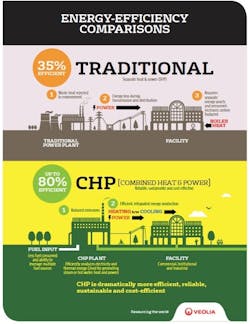The Medical Area Total Energy Plant (MATEP) supplies the critical energy needs of five hospitals affiliated with Harvard Medical School, as well as the Harvard Institutes of Medicine and Harvard School of Public Health. Owned by Mayflower Energy Partners, a joint venture between Morgan Stanley Infrastructure Partners and Veolia, the MATEP microgrid is also operated by Veolia under a long-term operations and maintenance (O&M) agreement.
Powered by natural gas-fired combustion turbines equipped with heat recovery steam generators, steam generators and several chillers, MATEP produces and distributes electricity, steam, and chilled water used for lighting, heating, domestic hot water, sterilization and air conditioning. Given the vital lifesaving missions of MATEP’s medical industry customers, redundancy and a 24/7 energy supply is imperative. In the event of a grid outage, MATEP can operate independent of the traditional electric grid, ensuring that critical operations continue at the hospitals and research centers served by MATEP.
Reducing carbon footprint with CHP
As a combined heat and power (CHP) plant, the MATEP microgrid simultaneously generates heat and electricity from a single fuel source. At times, MATEP is a tri-generation plant, utilizing steam to create chilled water as well. This highly efficient process requires significantly less fuel than when electricity and thermal energy are produced separately, resulting in avoided carbon emissions and greater energy reliability. In 2013, the U.S. Environmental Protection Agency recognized MATEP with the ENERGY STAR CHP Award for its superior efficiency and environmental achievements. Their analysis indicated the CHP system prevents greenhouse gas (GHG) emissions by an estimated 117,500 tons annually – equivalent to the emissions generated by the electric usage of more than 13,000 homes.
MATEP is a microgrid, a power network that can operate independently of the electric grid to ensure an uninterrupted energy supply.
MATEP microgrid: History and background
MATEP’s origins date back to 1906 when Harvard University built a powerhouse only yards from where the facility stands to provide steam and electricity for the Harvard Medical School. It was later converted to a steam and chilled water facility when economical electricity became available commercially from the local electric utility. In the late 1960’s, Harvard University and several area hospitals collaborated on alternative methods to meet future utility needs – paving the way for the total energy plant.
A key driver for the development of the CHP system was to increase energy reliability by decreasing dependence on the local utility. Built in late 70’s by Harvard, MATEP has undergone several major improvements over the years. In the early 2000’s, the CHP plant was expanded to improve operating efficiency and reliability and to meet the growing needs of the connected facilities it serves.
MATEP By The Numbers
74 buildings served
5 Harvard-affiliated hospitals
103,000 inpatients annually
2.4 million outpatients annually
117,500 tons: annual reduction of the region’s greenhouse gas emissions (analysis by the EPA)
1 million pounds of steam per hour produced
84 megawatts (MW) of electricity produced
42,000 tons chilled water capacity
EPA award: 2013 ENERGY STAR CHP Award
For over a quarter century, MATEP’s energy island capability has ensured reliable steam, chilled water, and electricity for Boston’s prestigious hospital facilities.
Attendees of Microgrid 2017 can tour the MATEP microgrid while at the Boston conference. Find out more here.







